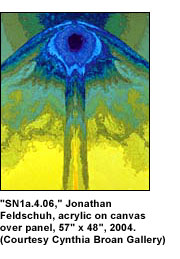WASHINGTON, Sept. 15 -- Artist Jonathan Feldschuh said he was a junior at Harvard, studying physics with distinguished professor Howard Georgi, when he realized physics wasn't right for him. His adviser was flabbergasted when Feldschuh told him that, despite graduating summa cum laude, he wanted to pursue art and abstract painting instead. But Feldschuch said his art remains heavily influenced by his science background.
 "I began to use iconic scientific images as a starting point for paintings, mostly images from the Hubble Space Telescope and other orbital observatories," he said. "People would be able to see the images from across the room and recognize them as iconic images, but up close the paintings' surfaces hold the most interest."
"I began to use iconic scientific images as a starting point for paintings, mostly images from the Hubble Space Telescope and other orbital observatories," he said. "People would be able to see the images from across the room and recognize them as iconic images, but up close the paintings' surfaces hold the most interest."
The common ground shared by art and science is the theme of an art exhibit featuring Feldschuh and sculptor Craig Schaffer that opens today in Washington. The exhibit is sponsored by the American Association for the Advancement of Science (AAAS) Art of Science and Technology Program. The program's goal is to display work that reflects the centuries-old interaction of art and science in all areas of scientific inquiry.
Schaffer said, "Artists and scientists have long observed that the inherent properties of units and the rules that govern growth and interaction create distinctive patterns at all levels of organization. The laws by which process produces pattern -- and which help define what life is -- are more basic than life itself and pervade every aspect of existence."
His sculptures attempt to reflect this idea. The undulating lines of his "A Rose Is . . . " and the angular planes of "Explosive Growth," for example, both emulate life and growth.
AAAS is displaying the artists' works through Oct. 28 at its headquarters on the northwest corner of 12th and H Streets. A reception will be held there today from 5-7 p.m. Exhibit hours are Monday through Friday, 9 a.m. to 5 p.m.
For more information, visit: www.aaas.org